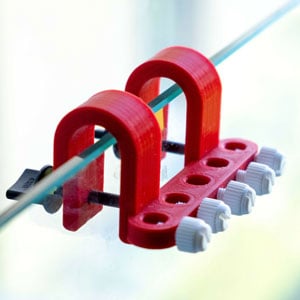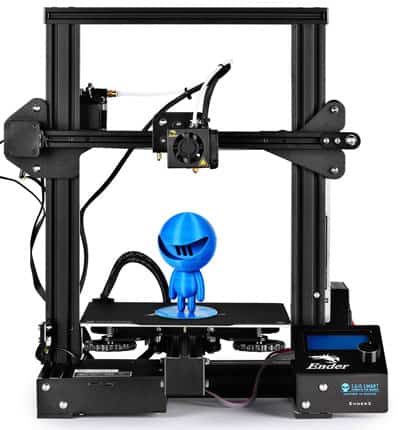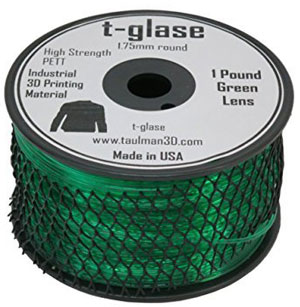The world of 3D printing is rapidly becoming more and more popular in people’s homes due to the rapid price reduction in printer technology. Most schools, libraries, and craft clubs have printers available for you to learn and print your own creations, never mind the thousands of people who own their own printers.
With printers starting in the $200 range the objects you can create to improve your aquarium setup are endless.
The problem that many printer owners now face is how to create a 3D-printed object that is aquarium safe!
White ABS and Food-Grade PETG are the recommended aquarium-safe filaments to use when 3D printing parts for aquariums. PLA filaments are safe but can break down after a few months & Nylon can absorb water and swell. FDA-Approved printing filaments are great when wanting colored filaments.
I have based this article on FDM (Fused Deposition Modeling) printers which are the most common home-based 3D printers available.
If you would like to view some of these types of 3D printers to reference as you read, you can find a nice selection Here at Amazon.com and if you wish to look at the recommended printing filaments you can find the links for each material listed further down this article.
Read on to find out all there is to know about Aquarium-Safe 3D Printing…
What Is 3D Printing?
3D printing is a process by which a plastic filament is pushed through a heated nozzle that melts the plastic as the printhead moves around the printing area. This creates lines of plastic that harden as they cool. Layers of lines are built up to form the required shape. Shapes are modeled in Software.
3D printing is a process by which a plastic filament is pushed through a heated nozzle. This nozzle melts the plastic and the printer moves either the nozzle or the bed of the machine to ‘Draw’ a line of plastic.
Think of the layers like a loaf of bread. As each layer is printed, the object begins to take shape.
The shape of the object is designed using a very easy-to-use computer program which then converts the design into computer code, which the printer then uses to move the extruding nozzle around to create the designed object.
Which 3D Printing Filament Materials Are Aquarium Safe?
With so many printers on the market, the number of filaments available is staggering. Finding the right one is paramount for keeping your livestock safe.
Here are the Most Common 3D Printing Filament Materials:
- PLA
- Nylon
- PET/PETT/PETG
- ABS
Is PLA for 3D Printing Aquarium Safe?
PLA is aquarium-safe but it is made of cornstarch that will begin to degrade in water and your printed object will fall apart within 6 months. It can be sealed using an epoxy or lacquer that once allowed to fully cure will be safe in the aquarium and not allow the print to degrade.
You can Find a Highly Reviewed PLA Filament in a Range of Colors
Here at Amazon.com
Non-Toxic Epoxy Resin for Sealing Prints
Available Here at Amazon.com
Krylon Fusion Clear Laquer is Also Great for Sealing Once Fully Cured
Find it Here at Amazon.com
Is Nylon for 3D Printing Aquarium Safe?
Nylon can absorb water and swell over time making submerged prints unusable. FDA approved Nylon works well if using to print objects for use out of the water or underwater prints can be sealed using an epoxy or lacquer that once allowed to fully cure will be safe in the aquarium.
Just like PLA, allow at least 1 week for any epoxy or lacquer to fully cure before placing the print into the water.
Taulman Nylon 910 FDM3D is a Recommended Aquarium Safe 3D Printing Filament
Find it HERE at Amazon.com
Is PET/PETT/PETG for 3D Printing Aquarium Safe?
PET, PETT, and PETG are all safe filaments to use for 3D printing aquarium items. It is the material used to manufacture drinks bottles and food containers so is safe to use within your aquarium. Ensure the 3D filament you purchase is FDA approved to be extra safe if placing in a saltwater Aquarium.
Is ABS for 3D Printing Aquarium Safe?
ABS for 3D printing is aquairum safe. Most of the plastic products used within the aquaiurm industry are manufactured from ABS. Ensure the filaments do not contain any toxic dyes and select an FDA approved filament to be sure. White and Black ABS are the most common aquarium safe filaments used.
This is the material that most aquarium products are manufactured from. Pump casings, Brackets etc. It is very durable and readily available.
Are Colored 3D Printing Filaments Aquarium Safe?
Many dyes used in 3D printing filament are not safe for use in aquariums. Over time dyes can leach toxins into the water killing all aquarium livestock. Only source non-toxic, FDA approved colored filments whaen wanting to submerge a colored 3d Print under water in an aquarium.
Most undyed or colored filaments are white. This is by far the safest option if you want to make an object that will be submerged. If you want to be safe use just a white filament. If you must have a colored object – A black powerhead guard for your Anemone tank, then these are the filaments I would suggest:
T-Glase
T-Glase is a non-toxic FDA approved polymer that was designed for use in the scientific, medical and food industries. It comes in a range of colors that also fall under the above approvals, making it perfect for use in saltwater aquariums.
The TaulmanRrange of T-Glase Filaments are a Great Option if You are Wanting to Print Something in Color.
You can find their selection HERE at Amazon.com
What Can I Print Using A 3D Printer For My Aquarium?
The most common items that I see being created for aquariums are to improve someone’s setup or to solve a problem.
Below are some examples of 3D printed aquarium parts:
- Dosing Tube ClampsM
- Dosing Hose Brackets
- Sensor Holders
- TestKit Tube Racks
- Light Brackets
- Feeding Funnels
- Frag Racks
and on and on…
If you can think of something that can aid you in your maintenance or neatening up your installation then chances are it’s been designed somewhere or you can have it designed for you.
Where Can I Get Things Designed & Printed For My Aquarium?
3D printing is rapidly becoming very popular, especially amongst the younger generation. In fact, if you asked any of your children, nieces, nephews, and the like chances are one of them will know about it and know someone who has a printer.
If you do not own a 3D printer you can get items printed at many libraries, community clubs, 3D printing clubs, via high-school students or via online printing companies. Once the print has been designed on a compatible software the file can be transferred via email or flash drive to the printer.
Many schools and libraries now have printers and you may be able to contact the school and see if you can have them create you parts as part of a design project. Libraries often have kids that use the printer and are looking for new things to design. It’s super cheap too!
My local library charges 10¢ per gram of filament used and the parts weigh nothing! The tube holder below would only cost you several dollars!
You could always buy your own roll of filament and then have them print using that so you can be sure your objects are aquarium safe.

Many of the software programs used to create these parts are free to download, with many of them being very simple to use as they are aimed at children. There are some great tutorials if you would like to learn yourself.
Here are some free Design Software Programs you may want to look at:-
Getting Your Own 3D Printer
If you want to try your hand at 3D printing there are some incredible 3D printers available now and their prices just keep dropping! I remember looking at 3D printers several years ago and they were so expensive it was just cheaper to buy off-the-shelf frag racks and clamps etc. Not any more!
Now you can have your own printer for only a few hundred dollars and the world it opens up to you is phenomenal!
I am looking to purchase my own 3D printer very soon and I have been really impressed the Creality printers on the lower price end of the market and PRUSA on the higher end. I highly recommend you check them out and see for yourself.
You can find the Creality 3D Printers Here at Amazon.com
You can find the PRUSA 3D Printers Here at Amazon.com
Where Can I Buy 3D Printed Aquarium Parts?
If you are not the designing type of person but want to look at some items that may work perfectly for you, then take a look at 3D Reef Gear on Etsy.
Michael the owner is a saltwater aquarist himself and after printing his own parts he found many other aquarists really wanted his stuff too!
You can find his online store here:
>> CLICK HERE to go to 3D Reef Gear’s Etsy Store <<
Where Can I Find More Information On 3D Printing?
If you are interested in learning more about 3D printing and how you can design and make things for all aspects of your life there are a few ways I recommend:
Online Resources:
Local Resources:
Many cities have Makerspaces (Makerspace Directory) or 3D printing clubs. Google your local area and you will be able to find someone to steer you to the right place.
Further Reading
If you found this article helpful, you may find the following offer some help too:





